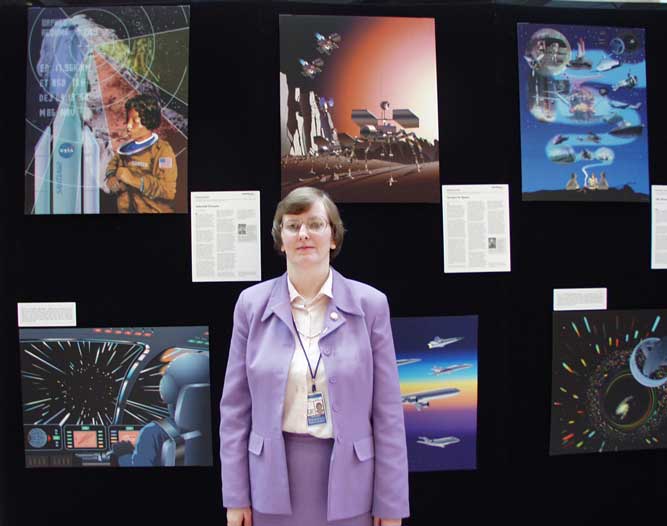Asteroid DreamsYou can read the story or use this link to check out the exhibit This story appeared in the September 2000 issue of Aerospace Frontiers, newsletter of NASA Glenn Research Center Dawn Jenkins |
||
Commanding this mission would be a dream fulfilled for Diona, a young black woman, whose love for science and technology was nurtured by her mother, Jessica Wilder. Jessica had earlier developed the life-suit, a special type of space suit that helped humans overcome the ill effects of weightlessness. The suit, which significantly reduced the amount of bone-mass loss as well as preserved muscle tone, was one of the many important advances since the turn of the century. Diona was confident that her years of experience and weeks training on mining would serve her well on this mission. She learned about her appointment as she was concluding the second of two 6-month tours onboard the International Space Station, Hope, which was still in service after 30 years of Earth orbit. A veteran pilot of many shuttle and X48 missions, Diona was selected to pilot the spaceship, Santiago that would become a revolving habitat for her and a culturally diverse crew. Joining Diona would be Juan Torino, who had developed special methods for mining the heavy metals--nickel, iron and platinum; Joyce Redden, a doctor and life support specialist; and Georgiy Popovich, a veteran cosmonaut. In addition to their space ship, Santiago, NASA had previously launched an equipment and supply vessel, the 49er, which contained the heavy equipment necessary for penetrating the surface. The 49er would arrive at the asteroid shortly before the main mission ship. The distant spacecraft was reporting all systems optimal. After this mission, the 49er would be left at the asteroid, where a future crew would refurbish it in 2025, and with any luck, another in 2029. During a previous close-Earth approach of Orpheus in 2017, a robot probe, Eurydice, was sent to explore the asteroid in great detail. One of the most successful asteroid exploration vessels, Eurydice, discovered a large quantity of heavy metals as well as a "deposit" of a mass of water ice. The water was evidently left over from some impact between the main body of Orpheus and an ice body. As a result of this finding, a secondary goal of the mission would be to send part of this hunk of ice hurtling toward Mars, where it would eventually be used to help support a fledgling colony, now being developed on the Martian surface. Diona was excited by the scientific investigations she and the crew would perform. They might discover clues to the origin of the solar system or uncover pieces to other cosmological puzzles. There was much more exploration and development to come before humans could declare themselves free from the danger of extinction due to a disaster in the solar system. As she gazed upon the rocket bearing Santiago before climbing the entryway, she saw the future unfolding before her. This mission to Orpheus was but one more step on the path to the stars. |
|
Note: The asteroid 3361 Orpheus was discovered in 1982 by C. Torres
in Santiago, Chile. It is an Apollo-type, planet-crossing asteroid about
which very little is known. Exploration and mission dates are based on
observed orbital elements but the description of its makeup is fanciful,
the real truth is waiting for future investigators to discover. More
information on NEOs is available at my web site, Astra's Star Gate, on
the world wide web at http://www.astras-stargate.com |
Dreaming of Space - Traveling ExhibitAsteroid Dreams was created for a six-part series that was published in the NASA Glenn Research Center's Aerospace Frontiers, October 2000. Stories by personnel who work at the center were asked to submit stories to illustrate their ideas of near-term space exploration. I was asked to submit my idea by the editor. The result of that request is the above story, "Asteroid Dreams." I believe the asteroids are the answer to our space exploration needs because of the resources they contain. It may someday become crucial to our survival on earth to attain the technology that will enable us to manuever one of these giant rocks if our gravity well ever attracts one into an orbit that intersects with the surface of our little world. The artwork for Asteroid Dreams was created by an artist also employed at the center.
The traveling exhibit has traveled the country, featuring the ideas that NASA's visionaries have crafted. The stories featured feasible new technologies and near-term space exploration vistas, such as the human activities on lunar and martian surfaces as well as other scenarios. My picture was taken at Tower City in Cleveland, OH, at a NASA outreach exhibit held in conjunction with Space Camp during the spring of 2001.
Return to Astra's NEO Page Site Navigation | Astra's Stargate Home | Astronomy | ATM | OTAA | StarWimin | MayaAstro | Space | Links | |


